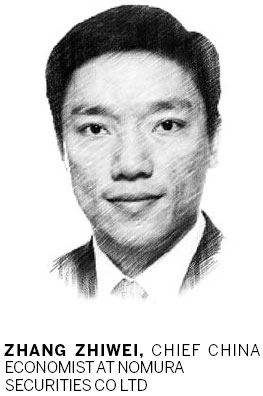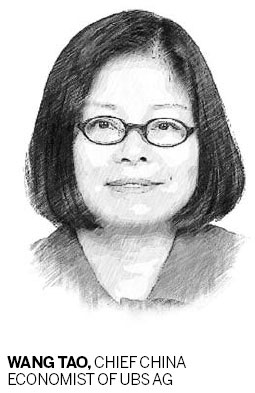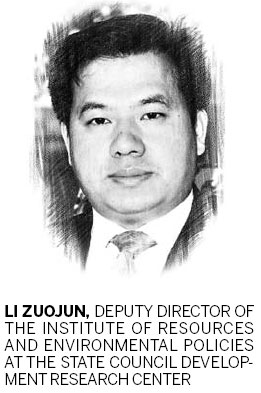


Editor's Note: Listed State-owned enterprises are sending out profit warnings. Small private firms are begging for government rescues. Growth forecasts are being lowered. The Shanghai Stock Exchange index is falling. It's hard to say there's nothing wrong with the Chinese economy these days, even though it is still leading most other major economies in speed of growth.
But why? Why is the central government, which holds perhaps the world's largest amount of cash, so reluctant to spend its money on building new industrial parks and new cities?
Why, despite their announced ambitions, have local governments perhaps not got as much credit as they had hoped for in their capital investment plans?
In fact, the complaints that people often hear about - dwindling orders, fewer deals, and falling revenues - are the results of a country that is trying to wean itself off its old growth model. That model has a heavy reliance on exports, which is no longer realistic, and on building ever more-expensive houses, which can only create a bubble economy that, when it bursts, would wipe out the savings of many middle-class families.
Some government-led investment projects may cushion the slowdown a bit. They are useful for the short run. But they won't catapult China into a new boom cycle, as many economists have pointed out.
So, what to do? Where to go? With these questions, three economists offered their predictions for the Chinese economy.
Situation may continue to decline in the short run
The economic risks in the third quarter are likely to rise, although we predict that the GDP growth pace may slightly accelerate to 7.7 percent between July and September from the second quarter's 7.6 percent.

If extreme conditions appear in the second half, they may drag down full-year GDP to less than the 7.5 percent target, which is adding to top policy makers' concerns.
The government's estimates about the economic slowdown may be more optimistic than merited by the real situation. The government's unclear and weak policy adjustment may have delayed the economic rebound.
According to recent economic indicators, the situation may be even worse in the near term, mainly due to the sharply declining exports.
The most important factor affecting the economy in the fourth quarter and next year will be the property sector, which accounts for about 27 percent of all fixed-asset investment. It will also determine whether related industries, including the cement and steel production industries, can rebound in the last three months of the year.
Some leading economic indicators, such as data for new land for real estate development and land transactions, have shown faster growth, but it's uncertain if the government will further tighten property control policies.
The government may be required to increase housing supply, rather than continuing to control home purchases. The confidence of property developers should be supported.
We expect investment growth to pick up in the fourth quarter, driven by strong infrastructure and housing investment.
The government still has space to adjust macro policies, depending on the evaluation of the current economic situation. Authorities may also have to improve their tolerance of slowing growth.
The People's Bank of China is likely to reduce the reserve requirement ratio again for the rest of the year, and bank lending may steadily rebound if investment is boosted.
The National Development and Reform Commission recently approved 25 new subway lines, which may effectively increase bank lending and contribute to the economic rebound.
However, previous investment stimulus plans by local governments may be difficult to achieve amid the strict regulations. On the other hand, the current risk of local governments' funding platforms is still under control.
We expect the September PMI to increase to 50.2, higher than the expansion-contraction watershed of 50, based on the rebound of new orders. But the recovery will be modest.
Monetary policy easing in the United States may bring both advantage and disadvantages to China's economic development. In the short term, it can boost demand and facilitate China's exports. But in the long run, it may increase inflationary pressure by lifting commodities prices.
We expect the CPI in the fourth quarter to bounce back, but still be less than the year's target of 3 percent.
A cyclical rebound will come on higher liquidity
UBS AG has cut its forecast for GDP growth in the third quarter to 7.3 percent year-on-year from 8 percent. And the development pace in the last three months may continue to decrease to 7 percent, resulting mainly from the government's slower policy adjustments and from weaker export increases, which will offer enough support to reach the GDP target of 7.5 percent for the entire year.

A modest sequential recovery may start in the fourth quarter, and the slight rebound trend is expected to continue into next year. GDP is predicted to grow at a rate of 7.8 percent in 2013.
The government's policy stance has shifted toward boosting growth, but it is not strong enough. Many infrastructure construction projects are still lacking money.
The dim economic indicators seen for July and August, including the weaker increase in industrial production and slower investing in manufacturing, may push the government to take more aggressive measures.
Banks may ease their controls on medium- and long-term loans as well as issue more corporate bonds. Fiscal expenditures are expected to increase faster to support investments in railway construction.
The property sector is likely to recover modestly in the next couple of quarters, judging by the fact that property new starts and land purchases surprisingly rebounded in August, when property sales increased by 13 percent from a year earlier.
But I don't expect to see any easing of real estate control policies. So giving the sector a sharp boost is impossible.
The government can also reduce risks by issuing more treasury bonds and slightly enlarging fiscal deficits to accelerate fixed-asset investment and boost development in middle and western China.
As for monetary policy, further lowering interest rates will have a very small effect. Companies have been borrowing less money recently, a result of their having massive inventories and there being strict controls on local-government financing vehicles.
Even so, the central bank still has room to cut the reserve requirement ratio one more time this year to give the economy more liquidity, which has been reduced by capital outflows.
China has seen sizable capital outflows in recent quarters, and this has caused some concern about domestic liquidity and the stability of the banking system. The global expectation for the value of the renminbi is turning to depreciation from the previous steady appreciation, as China's current account surplus continues to decrease and global demand remains weak. In addition, there has been a steady stream of capital outflows from Chinese households that are seeking to diversify into foreign assets.
The United States' third round of quantitative easing is likely to have less of an effect on the production and service sectors than did the second round, and its effect on the Chinese economy will be small in the short run.
We expect CPI to moderate slightly below 2 percent in September. In the fourth quarter, CPI may rebound to 2.7 percent year-on-year because of increases in pork and grain prices. It will continue to increase next year, showing an average level of 3.5 percent.
Danger of hard landing still looms large
The most stressful times for the Chinese economy are still ahead. This year will probably be one in which the economy is faced with challenges from many more directions than it has encountered before.

To be sure, with shrinking revenues from corporate taxes and land auctions, which we can expect to see starting now, local governments will be faced with unprecedented difficulties in coming up with the expenditures demanded by their ambitious development programs.
A considerable portion of local debt is coming due this year and, when debt payments pile up in a short span of time, they could lead to the virtual bankruptcy of some local governments around 2013.
Although banks will be made to rearrange their payment terms and share part of their debt burden, doing so will in turn bring risks to the country's entire fiscal and financial system.
I think the danger of the economy having a "hard landing" will persist throughout 2013. And that's why I'm calling 2012 "the most dangerous year".
In the meantime, a larger number of small and medium-sized enterprises could be closed down, a result of the industry's worse overcapacity and the economy's lack of consumer spending. As local governments and financial institutions are snowed under by immediate difficulties, the goal of rebuilding the country's growth model will appear rather distant.
China should be cool-headed enough to understand that it is only natural for an economy that has had double-digit GDP growth for so many years to enter a slow period. And that might not even be a bad thing - especially if it provides the time for more serious work on reform and restructuring and a better foundation for China's next boom cycle.
So, despite the current slowdown, I am skeptical of suggestions that call for the government to speed up the economy's growth by loosening its controls on the real estate market. Such a change could easily lead to an economic bubble.
Admittedly, the real estate industry has a role of its own in urbanization and industrialization. But it cannot contribute as much as manufacturing to the country's ability to compete. It should therefore never be allowed to dominate economic progress and should be assigned a supporting role.
In contrast, innovation in technologies and reform in management should be the two biggest driving forces in the Chinese economy.
State-owned enterprises can contribute to the nation's growth in the short term. But only companies with a competitive edge, rather than administrative protection and monopolistic interests, can sustain their expansions and be winners.
Rather than the real estate industry, the hope for China's future economy will come from enterprises emerging from competition in important industries such as new-generation information technology and new-energy, new-services and new-farming operations.
In monetary policies, policymakers still have weapons to fight the current difficulties. They can, when necessary, further ease monetary policies. But those shouldn't be taken as the only means of generating economic growth.
Growth shouldn't depend merely on government policies. More favorable circumstances can be established by a variety of reforms, and I must say at this point that I cherish high expectations for the reforms that may take place following the approaching 18th National Congress of the Communist Party of China.
The top leadership succession scheduled for that time may usher in a new round of reform for government agencies and lead government bodies to further simplify their approval procedures and give enterprises more leeway to compete in the marketplace.
By the same token, I also believe that the economy's difficult period, that between 2012 and 2013, if managed well, will serve as a good transition to a new golden era of economic development.
 Infographic: Highlights of China Q1 economic data
Infographic: Highlights of China Q1 economic data
 Top 10 luxury cars at Beijing auto show
Top 10 luxury cars at Beijing auto show
 Highlights of smart hardware on display at 2016 GMIC Beijing
Highlights of smart hardware on display at 2016 GMIC Beijing
 Two students return from abroad to open beer factory
Two students return from abroad to open beer factory
 Man aims to provide freshest ice cream possible
Man aims to provide freshest ice cream possible
 Top 6 domestic new-energy vehicles at Beijing auto show
Top 6 domestic new-energy vehicles at Beijing auto show
 Hanover Fair opens with Sino-German alliance launch
Hanover Fair opens with Sino-German alliance launch
 Five Chinese companies with exclusive broadcasting rights to sports event
Five Chinese companies with exclusive broadcasting rights to sports event